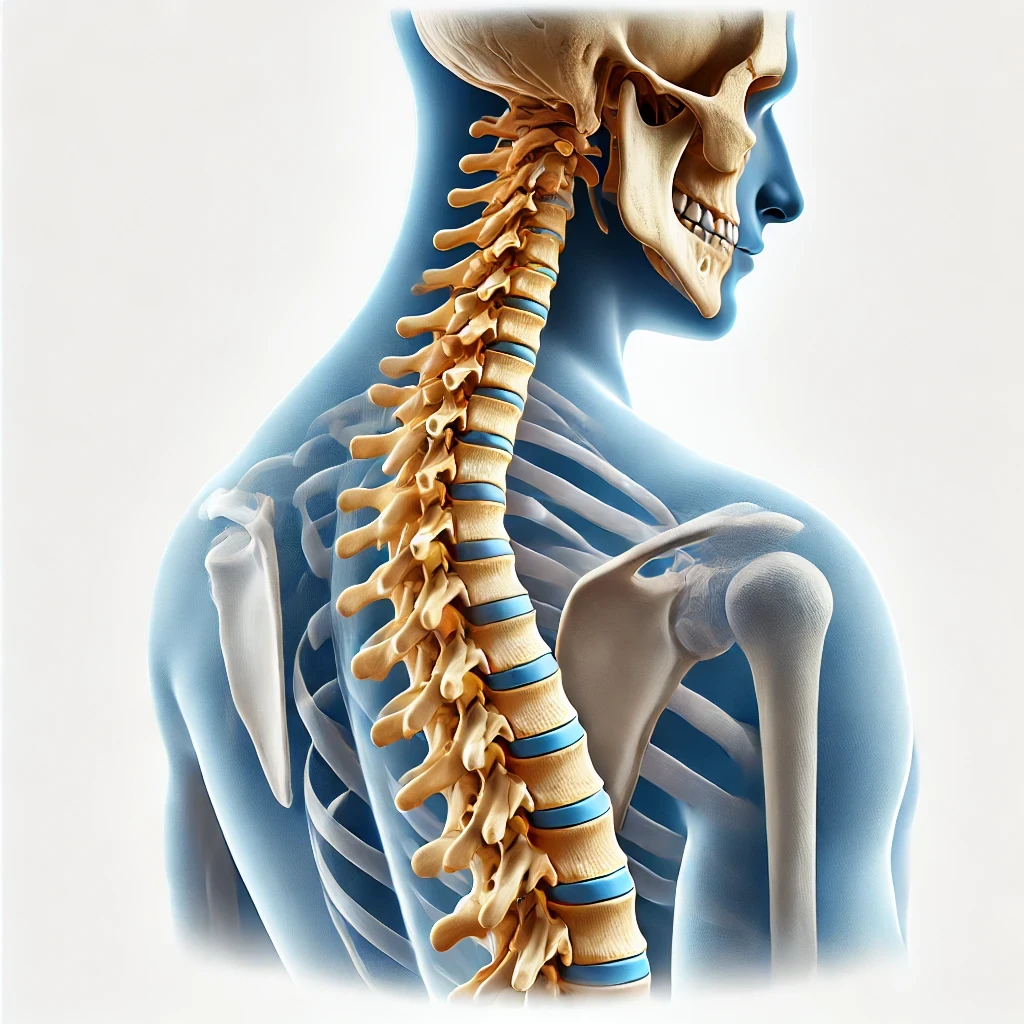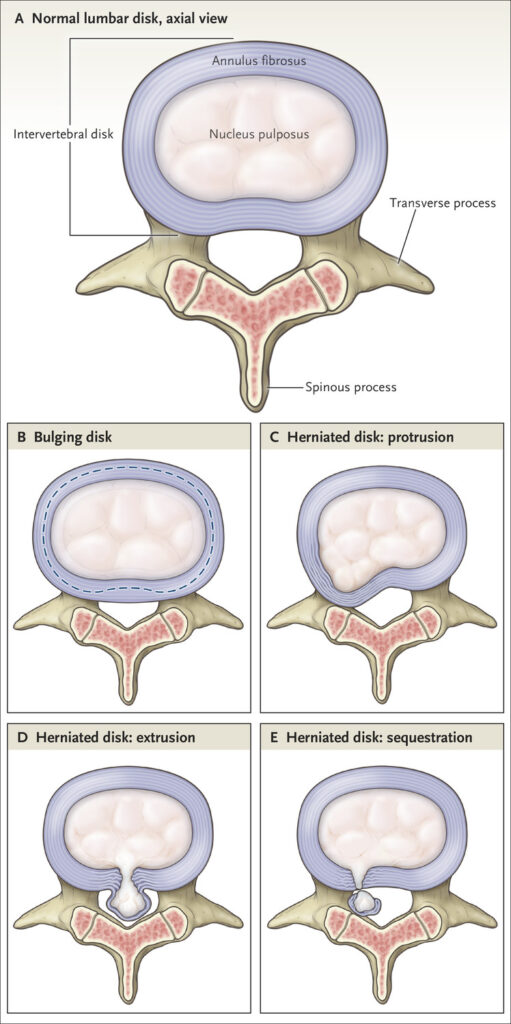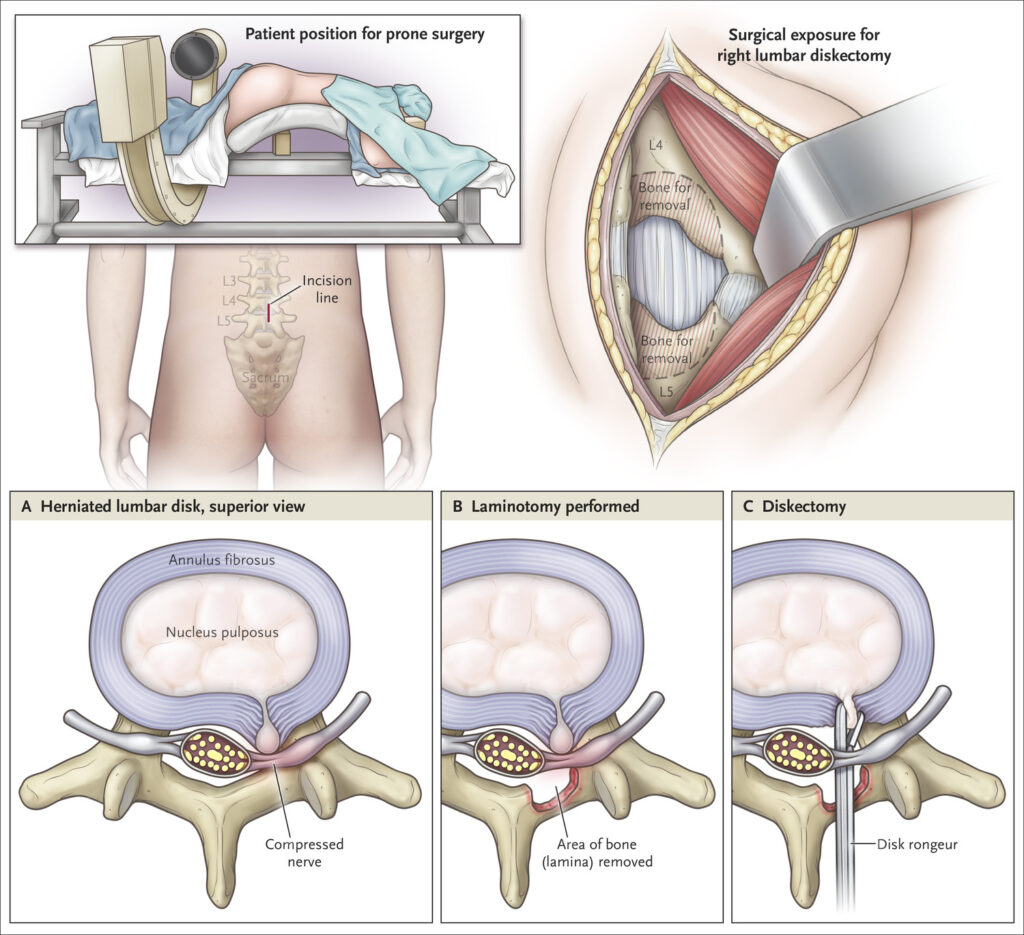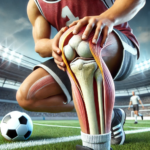💊 Bulging Discs
A bulging disc occurs when one of the intervertebral discs—the soft, gel-filled cushions between the vertebrae—extends beyond its normal boundary, typically without breaking through the outer layer. This condition is often a result of gradual wear and tear, known as disc degeneration, where the outer layer of the disc (annulus fibrosus) weakens and bulges outward due to pressure from the inner material (nucleus pulposus). The prevalence of bulging discs increases with age, with the lumbar spine (lower back) being the most commonly affected area due to weight-bearing, but the cervical spine (neck) is also frequently affected.

Causes and Risk Factors:
Just like the meniscus in the knee, the spine’s intervertebral discs act as shock absorbers, providing flexibility and cushioning between bone. Over time, repetitive stress, poor posture, obesity, and activities that place excessive strain on the spine, such as heavy lifting or high-impact sports, can contribute to disc degeneration. This degeneration weakens the disc’s outer layer, causing it to bulge outward. While aging is the most significant risk factor, other causes include trauma, genetic predisposition, and conditions that increase spinal load, such as being overweight or having a sedentary lifestyle. Bulging discs can also result from improper lifting techniques or sudden injuries.
A bulging disc may press on nearby nerves or even the spinal cord itself, leading to localized pain, stiffness, and potentially radiating symptoms like tingling, numbness, or weakness in the limbs, depending on the location of the bulge. Unlike a herniated disc, where the inner disc material leaks out, a bulging disc typically maintains an intact outer layer, but it still poses a risk of progressing to herniation if not managed appropriately.
🤔 Why you need to know:
Understanding bulging discs is essential because they can lead to discomfort, mobility issues, and potentially more severe conditions like herniated discs or nerve damage if left unmanaged. Here are some key points to consider:
- Symptoms: Many people with bulging discs experience localized pain, tingling, numbness, or weakness in the arms or legs if the bulge compresses a nerve root. Symptoms often vary depending on the disc’s location and the extent of nerve involvement.
- Complications: If left untreated, a bulging disc can progress to a herniated disc, where the inner disc material pushes through the outer layer, causing more severe nerve compression. This can lead to chronic pain, significant nerve damage, muscle weakness, or in severe cases, conditions like sciatica or cauda equina syndrome, which require urgent medical intervention. When a disc herniates, it not only causes mechanical compression of nearby nerves but also releases pro-inflammatory cytokines like TNF-alpha and IL-1. These substances can diffuse into the surrounding tissues and irritate nerves that are not directly compressed by the disc, leading to pain that can radiate or appear in unexpected areas. This inflammatory response can sometimes cause symptoms that seem disproportionate to the actual size or location of the herniation, making diagnosis and treatment more challenging even for seasoned physicians.

Panel A shows a normal lumbar intervertebral disk. Panel B shows a bulging disk. The dashed line indicates the normal disk space. Annular tissue extends beyond the normal disk space. Panel C shows protrusion of a disk. The greatest measure of the displaced material is less than the measure of the base of the displaced material. Panel D shows extrusion of a herniated disk. The greatest measure of the displaced disk material is greater than the measure of the base of the displaced disk material. Panel E shows sequestration of a herniated disk. The displaced disk material has lost all connection with the disk of origin. Adapted from Fardon et al.22
- Management and Treatment: Most bulging discs improve with conservative management, including physical therapy, anti-inflammatory medications, and lifestyle modifications such as weight loss and ergonomic adjustments. In more severe cases, epidural steroid injections or surgery may be necessary to relieve nerve compression and alleviate symptoms.
- Prevention Tips: Maintain good posture, engage in regular core-strengthening exercises, avoid smoking, and use proper techniques when lifting heavy objects to reduce the risk of developing bulging discs.
Exercises for Bulging discs:
Here is a video animation on a herniated disc:
Here is a diagram showing a microdiskectomy to address a compressed nerve:

Technique of Microdiskectomy: Open diskectomy with a standard surgical incision, often involving a laminectomy, has largely been replaced by microdiskectomy. A posterolateral disk herniation is shown (Panel A). The location where a small incision is made with the aid of a surgical microscope and a small laminotomy (Panel B) are shown. Although diskectomy (Panel C) is a common procedure, it is technically challenging. Surgery at the wrong spinal level can occur. Disk fragments are small, and visually distinguishing them from adjacent dura and nerve roots deep within a small incision is difficult, particularly with surgical instruments and pooling fluids in the way. Retraction of the nerve roots can result in their injury or in laceration of the dura. Newer minimally invasive techniques include endoscopic diskectomy and tubular diskectomy, the latter of which involves the use of a tubular retractor and muscle-splitting technique rather than muscle incision. Trials comparing minimally invasive techniques with microdiskectomy have generally shown similar rates of pain relief, complications, and reoperation.
And here is a video:
🧠 Trivia:
Up to 30% of people under 40 and over 60% of those over 40 have some form of disc bulging – even without any symptoms. This is one of the reasons you don’t just MRI everyone. The chances of finding something that is not related to any problem at all are very high. We call these false positives.



